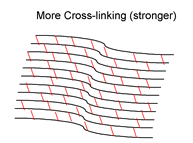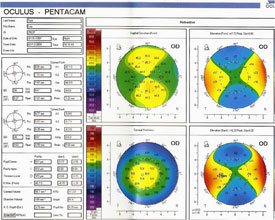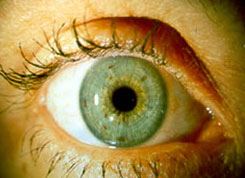Keratoconus Treatment
A-Corneal Cross Linking
Corneal Cross Linking is a non-invasive procedure that has been proven to strengthen the weak corneal structure in keratoconus. This method works by increasing collagen cross-linking, which are the natural "anchors" within the cornea. These anchors are responsible for preventing the cornea from bulging out and becoming steep and irregular (which is the cause of keratoconus).


The figures above show the parallel corneal layers (white) and the collagen cross-linking (red) which are increased after Corneal Cross Linking treatment.
The 30-minute Corneal Cross Linking treatment is performed in our office and is a one-time treatment. During the treatment, custom-made riboflavin eyedrops are applied to the cornea, which is then activated by a special light.
This is the process that has been shown in laboratory and clinical studies to increase the amount of collagen cross-linking in the cornea and strengthen the cornea. In published European studies, such treatments were proven safe and effective in patients.
The collagen cross linking with riboflavin has its roots in dermatology. Doctors were looking for a way to strengthen sagging skin and realized that triggering collagen cross linking was the way to achieve this. The process was taken one step further by eye physicians in Germany who performed initial studies. They reported results of treatments done as long ago as 1998, so there is a good track record for this procedure. It is important to note in these studies that the proper dosages of the components are a very important part of the treatment. When used properly, there were no negative effects.


The figure above demonstrates important corneal flattening in one patient eye before (left) and after this treatment (right).
Corneal Cross Linking treatments can also be combined with Intacs or Topography-guided laser treatment on the surface (LASEK) to flatten the keratoconus cone even more. In these cases, Corneal Cross Linking treatments stabilize keratoconus from getting worse as well as help the Intacs reverse the keratoconus steepening that had already occurred up to the time of the treatment. Corneal Cross Linking is also showing promise in stabilizing patients after radial keratotomy.
B-Intra-Corneal Rings (Corneal Ring Segments)
This is a procedure involving the insertion of curved clear plastic ring segments into the mid-peripheral cornea.
 Intra-Corneal Rings (brand name Intacs, Kerarings and Ferrara Rings) are clear, micro-thin prescription inserts made of biocompatible plastic. When placed between the layers of corneal tissue, they cause the central cornea to flatten and reshape the curvature of the cornea from within.
Intra-Corneal Rings (brand name Intacs, Kerarings and Ferrara Rings) are clear, micro-thin prescription inserts made of biocompatible plastic. When placed between the layers of corneal tissue, they cause the central cornea to flatten and reshape the curvature of the cornea from within.
 Intacs , Keraring and Ferrara Rings are now almost exclusively used as a salvage or temporizing treatment in cases of abnormal corneal curvature, with asymmetry and/or distortion of normal anatomy. Typically, it is used now in the context of keratoconus or post-LASIK ectasia, where the implanted ring segments are thought to act by buttressing or structurally supporting an area of otherwise weak corneal tissue. Some surgeons report favorable results in some of these cases. Even with imperfect predictability of results, this procedure is a reasonable option in certain situations involving abnormal or distorted corneal curvature (due to thinning and/or biomechanical bulge), which may delay or avert the need for more invasive, higher-risk procedures such as corneal transplantation.
Intacs , Keraring and Ferrara Rings are now almost exclusively used as a salvage or temporizing treatment in cases of abnormal corneal curvature, with asymmetry and/or distortion of normal anatomy. Typically, it is used now in the context of keratoconus or post-LASIK ectasia, where the implanted ring segments are thought to act by buttressing or structurally supporting an area of otherwise weak corneal tissue. Some surgeons report favorable results in some of these cases. Even with imperfect predictability of results, this procedure is a reasonable option in certain situations involving abnormal or distorted corneal curvature (due to thinning and/or biomechanical bulge), which may delay or avert the need for more invasive, higher-risk procedures such as corneal transplantation.